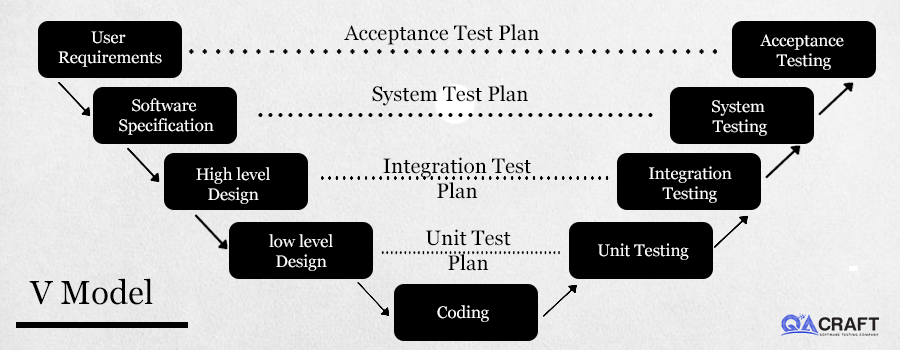14 Apr

What is V- Model?
The V-model is known as the validation and verification model. According to the V-model, each stage of the SDLC must be finished before moving on to the next. An improvement on the waterfall model is the V model. In the V-Model, software development and testing are executed in a parallel manner.
When do you use the V-model for software testing?
If the requirements are clear and straightforward, the V-model is used for small to medium-sized projects that have requirements that are clearly documented, defined, and fixed.
The project team is familiar with technology, which is not dynamic.
The V-model consists of a series of phases that are organized in a sequential manner, with each phase being associated with a corresponding testing activity. The phases of the V-model are as follows:
- Requirements analysis: In this phase, the requirements of the software are analyzed and documented. This includes identifying the functional and non-functional requirements of the software, as well as any constraints or limitations.
- System design: Based on the requirements identified in the previous phase, a detailed system design is created. This includes defining the system architecture, identifying components and modules, and creating detailed design specifications.
- Architecture design: In this phase, the system architecture is designed based on the requirements and the high-level design. The architecture design defines the overall structure of the system and the interfaces between different components.
- Module design: In this phase, the detailed design of each module or component is created. This includes defining the functionality, interfaces, data structures, and algorithms.
- Implementation: Based on the design created in the previous phases, the software is developed through coding and unit testing.
- Integration testing: In this phase, the individual components of the software are integrated and tested to ensure that they work together correctly.
- System testing: In this phase, the entire system is tested to ensure that it meets the requirements and works as expected.
- User acceptance testing: In this phase, the software is tested by the end-users to ensure that it meets their needs and works as expected in their environment.
- Deployment and maintenance: In the final phase, the software is deployed to the production environment and made available to users. The software is then maintained and updated as necessary to fix bugs, add new features, and address any issues that arise over time.

Advantages of the V-model:
The advantages of the V-model include its structured approach. With its structured approach, the V-model helps ensure that all aspects of the software development process are thoroughly planned and executed.
Risk management, improved quality, ease of understanding, and regulatory compliance. Following this helps minimize the risk of errors or omissions.
Additionally, the V-model emphasizes testing throughout the development process, which helps ensure that the software is of high quality and meets the required specifications. Its regulatory compliance ensures that the software meets regulatory requirements.
Disadvantages of the V-model:
The V-model also has several disadvantages. These include its rigid structure, limited scope, time-consuming nature, and lack of flexibility for accommodating changes or new requirements.
The V-model’s structured approach can also be seen as a disadvantage because it can be inflexible and slow to respond to changing requirements or circumstances.
Additionally, the V-model’s scope is limited to the defined requirements, and it may not be suitable for projects where the requirements are not well-defined or may change frequently.
Finally, the V-model can be time-consuming, especially for large or complex software development projects. Lack of flexibility
Conclusion:
The V-model is a popular Software Development Methodology that offers a simple and organized approach to software development. It helps to identify and mitigate risks early in the development process and ensures that testing is integrated into the process, which can improve the overall quality of the software. However, it can be too rigid and time-consuming, and it may not give enough attention to other important aspects of the software.
Akshay works as a Manual QA tester at QACraft. He is a Computer Engineer with a degree and has 6+ months of experience in manual testing etc. In his free time, he loves to explore his knowledge of QA and also loves photography and traveling.
Related Post
Recent Posts
Categories
- Agile Testing
- Android App Testing
- Automation Testing
- Banking Domain Testing
- Beta Testing
- cloud testing
- Corporate Life
- cross browser testing
- Cypress Testing
- desktop testing
- Domain Testing
- E-commerce Website Testing
- E-learning App Testing
- Functional Testing
- Game Testing
- Healthcare Domain Testing
- Infographics
- Ios App Testing
- Jenkins
- JIRA
- Katalon
- Manual Testing
- Mobile App Testing
- monkey testing
- Performance Testing
- Salesforce Testing
- security testing
- Selenium
- Software Testing
- static testing
- Test Environments
- vdfv
- Web Application Testing
© Copyright 2024 QACraft Pvt. Ltd. All rights reserved.
Contact : +91 9157786796



akshay